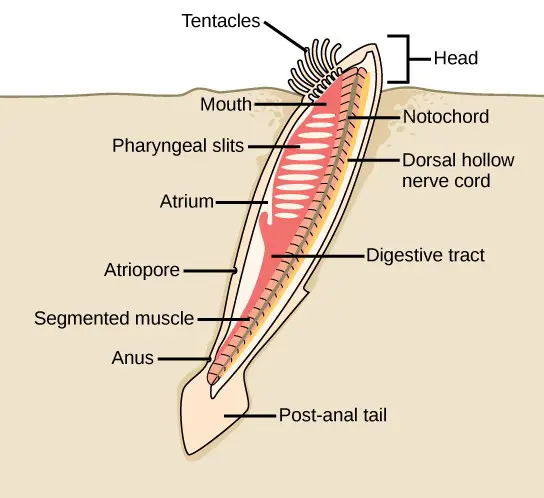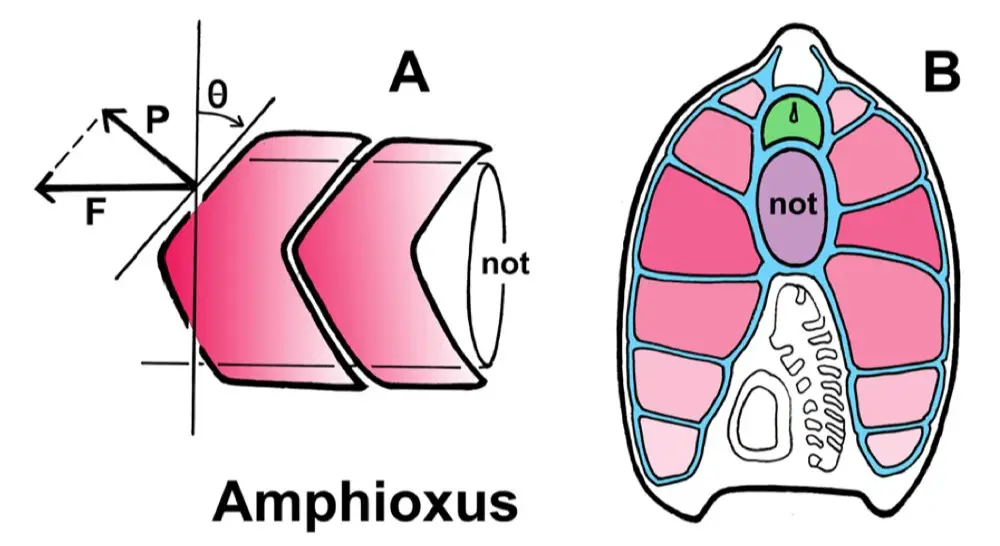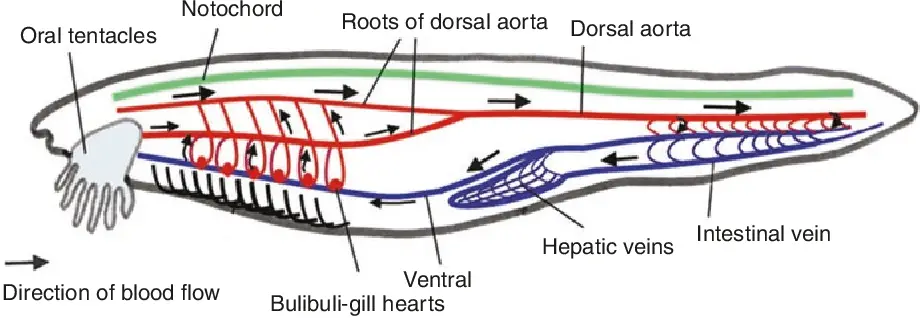Cephalochordate has all the basic Chordata characters but in a simple form, we will discuss all the characteristic features of subphylum Cephaochordata.
Table of Contents
They are Marine:
Members of subphylum Cephaochordata live in marine environments, they present in shallow water as well as in the deep ocean. But they prefer shallow coastal areas and the warmer ocean.

Sedentary:
They generally do not swim actively, they live in a sedentary state. In the shallow coastal areas they make burrows in the sand and most of the time they live inside the burrows. Inside the burrow, they keep their anterior part upward direction outside the burrows but when they are disturbed they come outside of the burrow.
Body Parts:
Their body does not contain any head part, the body is divided into two parts, the anterior trunk and posterior tail. The pointed anterior part of their trunk is known as the snout or rostrum.
External Appearance:
They are lance-shaped fish-like animals, the anterior and posterior ends are slender, body colour is whitish and due to transparent body wall they are translucent, their size is around 6 cm in length.
Appendages:
They do not have any paired appendages, the fins are all unpaired.
Exoskeleton:
The body is covered by any exoskeleton, the transparent body wall is the outer covering of their body, the epidermis is single-layered.
Special Arrangements of Muscle:
On their lateral side of the body muscle fibres are arranged in a special pattern, muscle present in segments. Each segment of muscle fibres have a ‘>’ shape, the segments of muscle are known as myotomes or myomeres.

Coelom:
During embryonic development archenteron forms coelom, so in Branchiostoma coelom is enterocoelous type. The coelom is reduced and limited in the pharynx region, the pharynx is surrounded by the atrial cavity.
Notochord:
The notochord is present throughout their life, the dorsal notochord is present throughout the length of the body. On the anterior side, the notochord extends beyond the cephalic region up to the rostrum, the notochord extends the cephalic region so they are known as Cephaochordata.
Pharyngeal Gill Slits:
On the lateral wall of the pharynx large number of gill slits are present in pairs but the gill slits do not open outside directly. The pharynx is enclosed by the atrial cavity so the gill slits open into the atrial cavity then the atrial cavity open outside through the atriopore present on the ventral side of the body.
Digestion System:
Digestion System is complete in Branchiostoma with an anterior ventral mouth and end in the anus, the mouth opening is encircled by the oral hood and buccal cirri.
Filter Feeder:
They are filter feeders, they create a water current that forces the water to enter into the mouth, along with the water current food particles and dissolved oxygen enter. The food particles present in the water current is collected into the pharynx through the mucous thread.
Respiration:
In Branchiostoma the gill slits have no special importance in respiratory gaseous exchange. The general surface area of metapleural folds and in the fin region take part in gaseous exchange.
Circulatory System:
They have a closed circulatory system, blood is colourless, no respiratory pigment or special blood cells are present in their blood. The circulatory system of the Branchiostoma do not have any heart, the contraction of the muscular wall of blood vessels give the blood direction to flow. In Branchiostoma hepatic portal system is present which is considered an important feature of Chordata.
Excretory System:
In Branchiostoma excretion occur through protonephridia, the solenocytes present in groups that takes part in the extraction of nitrogenous waste materials from the body fluid.
Nervous System:
The nervous system has a dorsal hollow nerve cord as the central nervous system, cerebral and spinal nerve as the peripheral nervous system and the nerve plexus in visceral organs constitute the autonomous nervous system. The nervous system of Branchiostoma do not have a brain but a slightly enlarged portion has a ventricle and the lumen of the nerve cord is filled with cerebrospinal fluid.

The spinal nerve has dorsal and ventral roots while the first pair of nerves or cerebral nerves have only one root.
Reproductive System:
In Branchiostoma males and females are separate but the gonads are similar, the gonads are present on both lateral sides below the myotomes in longitudinal rows. Fertilization external, development is indirect with a free-swimming larval stage, asexual mode of reproduction absent in Branchiostoma.
Reference Cephalochordata Characteristics Features Classification Examples and Diagram
Detailed Information on
Characteristics Features of Subphylum Urochordata
Classification of Subphylum Urochordata
Examples of Subphylum Urochordata: Clavellina, Salpa, and Doliolum
Examples of Subphylum Urochordata
Branchiostoma Habitat and Geographical Distribution
External Morphology of Branchiostoma
Body Wall and Endoskeleton of Branchiostoma
Coelom and Movement in Branchiostoma
Digestive System of Branchiostoma
Digestion and Feeding Mechanism in Branchiostoma
Respiratory and Reproductive System of Branchiostoma
Excretory and Reproductive System of Branchiostoma
Branchiostoma: Morphology, Digestive, Reproductive, Nervous System
Hi Everyone!!! Welcome to Imaluop. Imaluop always try to learn some new and he want to share to other people. Here we will try to learn various topics on Science, specially on Biological Sciences.